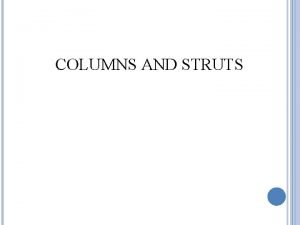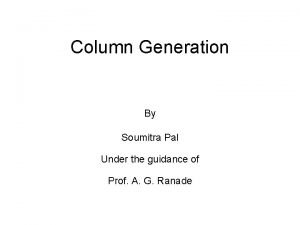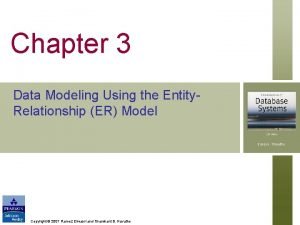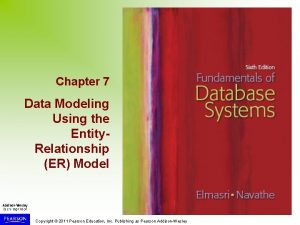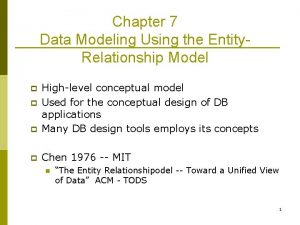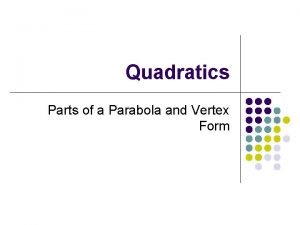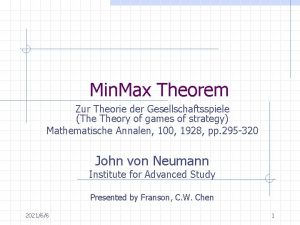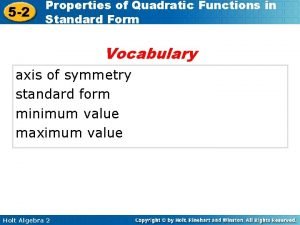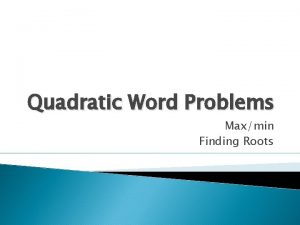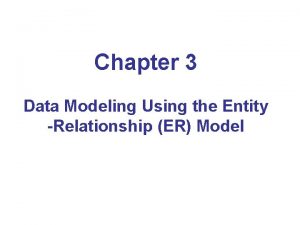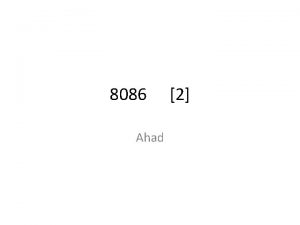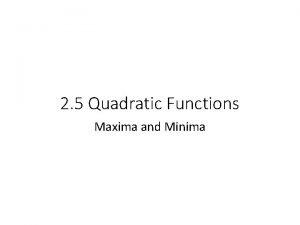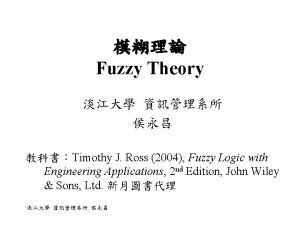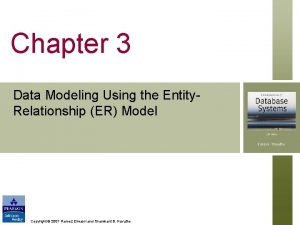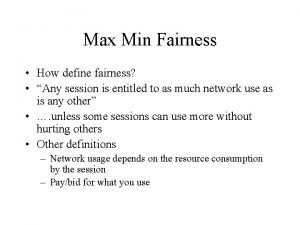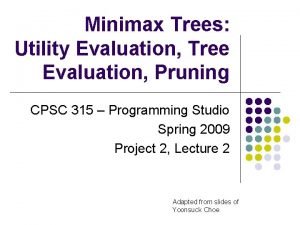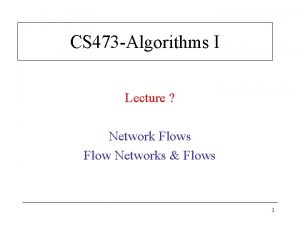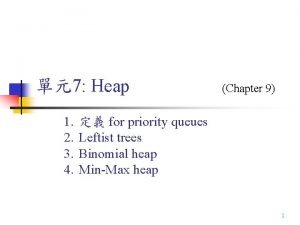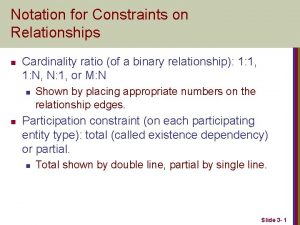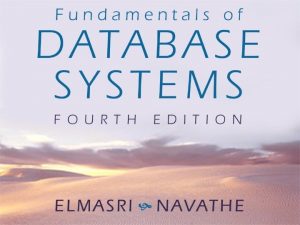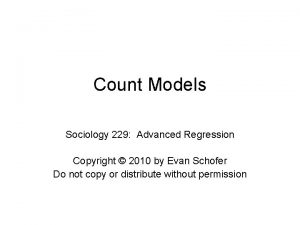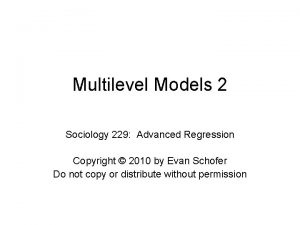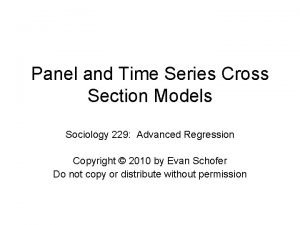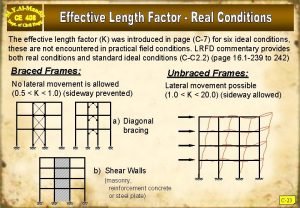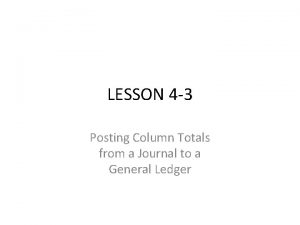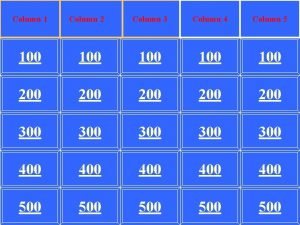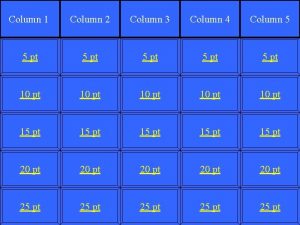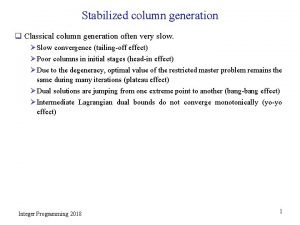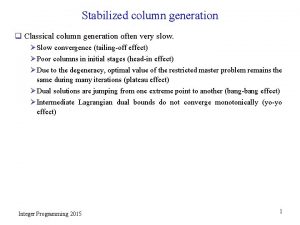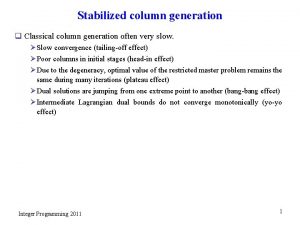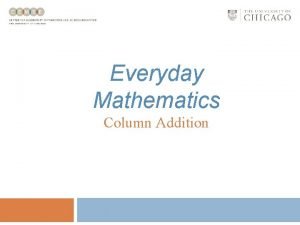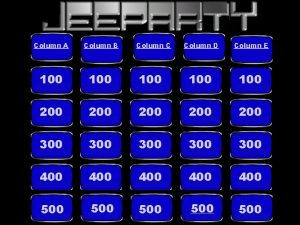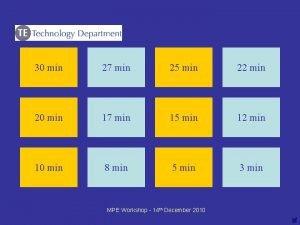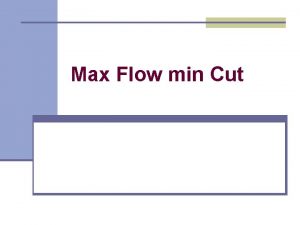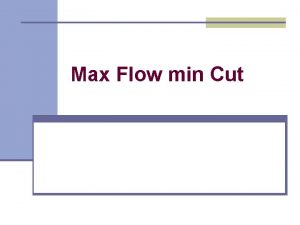Advanced LP models column generation min max min















































- Slides: 47

Advanced LP models column generation

min max

min max OK OK ?

Bin packing example bins of size K items of different types items of type i have size s(i) and there are n(i) of them problem put all items into the bins minimizing the number of bins




1 + 2 + 0 = 3 2 + 0 + 2 + 0 = 4 0 + 4 + 4 = 8 feasible patterns

x 1 1 + x 2 + + 2 x 11 + 0 + 2 + x 3 + 0 + x 4 + 0 + 1 x 5 + + 0 x 6 + x 7 + 0 = 3 0 x 12+ 2 x 13 + 0 1 x 4 + 0 0 x 5 + 4 0 x 6 + 3 0 x 7 = 4 0 4 4 + + + 4 + 0 + 2 = 8

min Si xi 1 2 0 0 1 0 0. . . . 2 0 0 4 3. . . . 0 0 4 4 4 0 2. . . . x integer 3 x = 4 8

min max OK OK ?

1 2 0 0 1 20 0. . . . 0 0 2 0 0 04 3 2. . . . 4 0 0 4 4 4 00 2 0. . . . 4 1 0 4 0 0 3 2. . . y 1 y 2 y 3 < 1 1 1 1. .

1 y 1 + 2 y 2 + 0 y 3 < 1 2 y 1 + 0 y 2 + 0 y 3 < 1 a 1 y 1 + a 2 y 2 + a 3 y 3 < 1 for all feasible patterns a 1 a 2 a 1 s 1 + a 2 s 2 + a 3 s 3 < max a 1 y 1 + a 2 y 2 + a 3 y 3 a 3 K < 1

max a 1 y 1 + a 2 y 2 + a 3 y 3 a 1 s 1 + a 2 s 2 + a 3 s 3 < a 1 a 2 a 3 K integer knapsack ! if max < 1 optimality ! otherwise add pattern maximizing knapsack

example bin capacity = 20 3 types: type 1: size = 7; quantity = 50 type 2: size = 5; quantity =100 type 3: size = 3; quantity = 70 x starting patterns generated patterns 2 0 2 25 0 4 0 y= ( 024 1/4 0 1/4 y= ( 1/3 4. 25 y= (. 35 0 0 6 0 1 5 53 bins 1/2 ) 1/6 ). 15 )

however, change quantities to solution is : x 1 x 2 x 3 x 4 52 = 26 = 23. 3 = 0 = 3. 8 53. 1 how to get an integer solution? 97 71

? ? compute the first |J|+1 knapsack solutions

compute the 5 longest paths 2 3 4 1 5 8 4 2 4 3 3 1 6 2 3 5 6 2 7 8 7 7 5 4 5 6 7 8

8 2 3 4 1 5 4 2 4 3 5 3 1 1 2 8 7 7 5 4 1 6 3 5 6 2 3 1 1 7 5 6 7 8

8 2 3 4 1 5 4 2 4 3 5 3 1 1 2 8 7 7 5 4 1 6 3 5 6 2 3 1 1 7 5 6 7 8

8 2 3 4 1 5 4 2 4 3 5 3 1 6 1 1 2 3 5 6 2 9 3 1 1 7 8 7 7 5 4 7 3 1 5 11 3 6 1 7 8

8 2 3 4 1 5 4 2 4 3 5 3 1 6 1 1 2 3 5 6 2 9 3 1 1 7 8 7 7 5 4 7 3 1 5 11 3 6 1 7 8

8 2 3 4 1 5 4 2 4 3 5 3 1 6 1 1 2 3 5 6 2 9 3 1 1 7 8 7 7 5 4 17 2 11 2 7 3 1 2 1 5 11 3 6 1 7 8

8 2 3 4 1 5 4 2 4 3 5 3 1 6 1 1 2 3 5 6 2 9 3 1 1 7 8 7 7 5 4 17 2 11 2 7 3 1 2 1 5 11 3 6 1 7 8

8 2 3 4 1 5 7 4 2 4 3 1 5 3 1 1 2 3 5 8 7 7 6 2 9 3 1 1 6 5 4 17 2 11 2 7 3 1 21 15 11 11 5 4 4 4 3 1 2 3 1 6 24 4 18 4 14 4 7 1 2 3 8

8 2 3 4 1 5 7 4 2 4 3 1 5 3 1 1 2 3 5 8 7 7 6 2 9 3 1 1 6 5 4 17 2 11 2 7 3 1 21 15 11 11 5 4 4 4 3 1 2 3 1 6 24 4 18 4 14 4 7 1 2 3 8

8 2 3 4 1 5 7 4 2 4 3 1 5 3 1 1 2 3 5 8 7 7 6 2 9 3 1 1 6 5 4 17 2 11 2 7 3 1 21 15 11 11 5 4 4 4 3 1 24 22 18 16 14 6 4 5 4 1 1 2 2 3 26 20 16 16 7 5 5 8 1 2 3 4

8 2 3 4 1 5 7 4 2 4 3 1 5 3 1 1 2 3 5 8 7 7 6 2 9 3 1 1 6 5 4 17 2 11 2 7 3 1 21 15 11 11 5 4 4 4 3 1 24 22 18 16 14 6 4 5 4 1 1 2 2 3 26 20 16 16 7 5 5 1 2 3 4 33 27 23 23 8 7 7 1 2 3 4

8 2 3 4 1 5 7 4 2 4 3 1 5 3 1 1 2 3 5 8 7 7 6 2 9 3 1 1 6 5 4 17 2 11 2 7 3 1 21 15 11 11 5 4 4 4 3 1 29 24 23 22 19 6 7 4 7 5 7 1 1 2 1 3 26 20 16 16 7 5 5 1 2 3 4 33 27 23 23 8 7 7 1 2 3 4

8 2 3 4 1 5 7 4 2 4 3 1 5 3 1 1 2 3 5 8 7 7 6 2 9 3 1 1 6 5 4 17 2 11 2 7 3 1 21 15 11 11 5 4 4 4 3 1 29 24 23 22 19 6 7 4 7 5 7 1 1 2 1 3 26 20 16 16 7 5 5 1 2 3 4 33 31 27 26 25 8 7 6 6 1 1 2 2 3

8 2 3 4 1 5 7 4 2 4 3 1 5 3 1 1 2 3 5 8 7 7 6 2 9 3 1 1 6 5 4 17 2 11 2 7 3 1 21 15 11 11 5 4 4 4 3 1 29 24 23 22 19 6 7 4 7 5 7 1 1 2 1 3 26 20 16 16 7 5 5 1 2 3 4 33 31 27 26 25 8 7 6 6 1 1 2 2 3

8 2 3 4 1 5 7 4 2 4 3 1 5 3 1 1 2 3 5 8 7 7 6 2 9 3 1 1 6 5 4 17 2 11 2 7 3 1 21 15 11 11 5 4 4 4 3 1 29 24 23 22 19 6 7 4 7 5 7 1 1 2 1 3 26 20 16 16 7 5 5 1 2 3 4 33 31 27 26 25 8 7 6 6 1 1 2 2 3

8 2 3 4 1 5 7 4 2 4 3 1 5 3 1 1 2 3 5 8 7 7 6 2 9 3 1 1 6 5 4 17 2 11 2 7 3 1 21 15 11 11 5 4 4 4 3 1 29 24 23 22 19 6 7 4 7 5 7 1 1 2 1 3 26 20 16 16 7 5 5 1 2 3 4 33 31 27 26 25 8 7 6 6 1 1 2 2 3

8 2 3 4 1 5 7 4 2 4 3 1 5 3 1 1 2 3 5 8 7 7 6 2 9 3 1 1 6 5 4 17 2 11 2 7 3 1 21 15 11 11 5 4 4 4 3 1 29 24 23 22 19 6 7 4 7 5 7 1 1 2 1 3 26 20 16 16 7 5 5 1 2 3 4 33 31 27 26 25 8 7 6 6 1 1 2 2 3

8 2 3 4 1 5 7 4 2 4 3 1 5 3 1 1 2 3 5 8 7 7 6 2 9 3 1 1 6 5 4 17 2 11 2 7 3 1 21 15 11 11 5 4 4 4 3 1 29 24 23 22 19 6 7 4 7 5 7 1 1 2 1 3 26 20 16 16 7 5 5 1 2 3 4 33 31 27 26 25 8 7 6 6 1 1 2 2 3

8 2 3 4 1 5 7 4 2 4 3 1 5 3 1 1 2 3 5 8 7 7 6 2 9 3 1 1 6 5 4 17 2 11 2 7 3 1 21 15 11 11 5 4 4 4 3 1 29 24 23 22 19 6 7 4 7 5 7 1 1 2 1 3 26 20 16 16 7 5 5 1 2 3 4 33 31 27 26 25 8 7 6 6 1 1 2 2 3

< max a 1 y 1 + a 2 y 2 + a 3 y 3 a 1 s 1 + a 2 s 2 + a 3 s 3 < a 1 a 2 a 3 1 K integer V(j)=optimal value for a knapsack of capacity j V(j) = max { V(j - s(i)) + y(i) : i= 1, . . . , n} V(j) > V(j - s(i)) + y(i) V(K) < 1 V(j) > 0 i= 1, . . . , n; j=1, . . . , K

min max

max b(i) y(i) V(j) > V(j - s(i)) + y(i) i= 1, . . . , n; j=1, . . . , K V(K) < 1 V(j) > 0 however this is the dual problem we need the patterns which are in the primal so let’s make the dual of the above problem

It turns out that the dual is a flow problem nodes capacity values (0, 1, 2, . . . , K) arcs each possible filling from capacity j to capacity j+s(i) dual variables flows on arcs

4 0 25 1 2 24 4 3 4 5 4 6 25 7 24 8 9 10 11 12 25+4 29 13 4 14 24 15 25+4 29 16 17 24 18 19 20

4 0 25 times the pattern 25 1 2 0 2 2 24 3 4 4 5 4 6 25 7 24 8 9 10 11 12 25+4 29 13 4 14 24 15 25+4 16 17 18 24 19 20

4 0 1 24 times the pattern 25 0 4 0 2 24 3 4 4 5 4 6 7 24 25 8 9 10 11 12 25+4 29 13 4 14 24 15 16 25+4 17 24 18 19 20

4 0 1 4 times the pattern 25 0 1 5 2 24 4 3 4 5 4 6 7 24 25 8 9 10 11 12 25+4 29 13 4 14 24 15 16 25+ 17 4 18 24 19 20

8 6 14 6 times

13 8 8 6 times 8 times

21 36 6 times 8 times 5 5
 Slenderness ratio buckling
Slenderness ratio buckling Delayed column generation
Delayed column generation Delayed column generation
Delayed column generation Local max
Local max Second generation vs first generation antipsychotics
Second generation vs first generation antipsychotics Lord you are good and your mercy
Lord you are good and your mercy Min max notation er diagram
Min max notation er diagram Ramez elmasri
Ramez elmasri Int b
Int b Min max notation er diagram
Min max notation er diagram Vertex form example
Vertex form example Definite integral sigma notation
Definite integral sigma notation Kerlinger research design
Kerlinger research design Min max theorem
Min max theorem Max-min
Max-min Minimax algorithm
Minimax algorithm Properties of quadratic functions
Properties of quadratic functions Max flow min cut problem
Max flow min cut problem Min max notation er diagram
Min max notation er diagram Max min quadratic word problems
Max min quadratic word problems Min max notation er diagram
Min max notation er diagram Contoh dari teknik pencarian searching tunggal adalah
Contoh dari teknik pencarian searching tunggal adalah Double-ended priority queue
Double-ended priority queue Min mode and max mode in 8086
Min mode and max mode in 8086 Min heap insertion time complexity
Min heap insertion time complexity Maximum and minimum values of quadratic functions
Maximum and minimum values of quadratic functions Max-min composition
Max-min composition Er diagram min max notation
Er diagram min max notation Max-min fairness example
Max-min fairness example Relative maximum and minimum
Relative maximum and minimum Minimax utility
Minimax utility Max-flow min-cut theorem
Max-flow min-cut theorem Min max heap data structure
Min max heap data structure Krähenfuß notation
Krähenfuß notation Min max normalization example
Min max normalization example Definite integral denotes
Definite integral denotes Max-min fairness
Max-min fairness Cardinality min max notation
Cardinality min max notation Lbo case study practice
Lbo case study practice Bank erd example
Bank erd example Min term max term
Min term max term Advanced regression models
Advanced regression models Advanced regression and multilevel models
Advanced regression and multilevel models Time fixed effects
Time fixed effects Shall will difference
Shall will difference Galvanized steel column
Galvanized steel column Effective length factor k
Effective length factor k Post the journal’s special amount column totals.
Post the journal’s special amount column totals.
